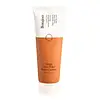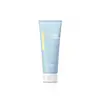What's inside
What's inside
 Key Ingredients
Key Ingredients

 Benefits
Benefits

 Concerns
Concerns

 Ingredients Side-by-side
Ingredients Side-by-side

Water
Skin ConditioningGlycerin
HumectantSodium Cocoyl Isethionate
CleansingDipropylene Glycol
HumectantGlycol Distearate
EmollientSodium Methyl Cocoyl Taurate
CleansingCoconut Acid
CleansingCoco-Betaine
CleansingZingiber Officinale Water
MaskingSodium Isethionate
CleansingSodium Chloride
MaskingButylene Glycol
HumectantMyristic Acid
CleansingSalicylic Acid
MaskingHydroxyacetophenone
AntioxidantParfum
MaskingCamellia Sinensis Leaf Powder
ExfoliatingCaprylyl Glycol
EmollientPolyquaternium-67
Caprylhydroxamic Acid
Zinc PCA
HumectantEthylhexylglycerin
Skin ConditioningPanthenol
Skin ConditioningMalt Extract
Skin ProtectingGardenia Florida Fruit Extract
Skin ConditioningDextrin
Absorbent1,2-Hexanediol
Skin ConditioningPropanediol
SolventHydrolyzed Hyaluronic Acid
HumectantAloe Barbadensis Leaf Extract
EmollientSodium Hyaluronate
HumectantBioflavonoids
Skin ConditioningCapryloyl Salicylic Acid
ExfoliatingBrassica Oleracea Italica Extract
AstringentHydroxypropyltrimonium Hyaluronate
Sodium Acetylated Hyaluronate
HumectantHyaluronic Acid
HumectantSodium Hyaluronate Crosspolymer
HumectantHydrolyzed Sodium Hyaluronate
Skin ConditioningPotassium Hyaluronate
Skin ConditioningWater, Glycerin, Sodium Cocoyl Isethionate, Dipropylene Glycol, Glycol Distearate, Sodium Methyl Cocoyl Taurate, Coconut Acid, Coco-Betaine, Zingiber Officinale Water, Sodium Isethionate, Sodium Chloride, Butylene Glycol, Myristic Acid, Salicylic Acid, Hydroxyacetophenone, Parfum, Camellia Sinensis Leaf Powder, Caprylyl Glycol, Polyquaternium-67, Caprylhydroxamic Acid, Zinc PCA, Ethylhexylglycerin, Panthenol, Malt Extract, Gardenia Florida Fruit Extract, Dextrin, 1,2-Hexanediol, Propanediol, Hydrolyzed Hyaluronic Acid, Aloe Barbadensis Leaf Extract, Sodium Hyaluronate, Bioflavonoids, Capryloyl Salicylic Acid, Brassica Oleracea Italica Extract, Hydroxypropyltrimonium Hyaluronate, Sodium Acetylated Hyaluronate, Hyaluronic Acid, Sodium Hyaluronate Crosspolymer, Hydrolyzed Sodium Hyaluronate, Potassium Hyaluronate
Water
Skin ConditioningGlycerin
HumectantCocamidopropyl Betaine
CleansingPropanediol
SolventPotassium Cocoyl Glycinate
Acrylates Copolymer
Polyglyceryl-4 Caprate
EmulsifyingHydroxypropyl Starch Phosphate
Sodium Chloride
Masking1,2-Hexanediol
Skin ConditioningLactic Acid
BufferingPotassium Cocoate
EmulsifyingEthylhexylglycerin
Skin ConditioningCitrus Aurantium Bergamia Fruit Oil
MaskingLavandula Angustifolia Oil
MaskingButylene Glycol
HumectantRosmarinus Officinalis Leaf Oil
MaskingCentella Asiatica Extract
CleansingPelargonium Graveolens Flower Oil
MaskingGardenia Florida Fruit Extract
Skin ConditioningCitrus Nobilis Peel Oil
MaskingMaltodextrin
AbsorbentBifida Ferment Lysate
Skin ConditioningHyaluronic Acid
HumectantGuaiazulene
AntimicrobialSqualane
EmollientCitric Acid
BufferingAllantoin
Skin ConditioningTocopherol
AntioxidantPanthenol
Skin ConditioningHydrolyzed Collagen
EmollientHamamelis Virginiana Leaf Water
AstringentHydrolyzed Hyaluronic Acid
HumectantCamellia Sinensis Leaf Extract
AntimicrobialJuniperus Communis Fruit Extract
PerfumingMelissa Officinalis Leaf Extract
Skin ConditioningSaponaria Officinalis Root Extract
Skin ConditioningSalvia Officinalis Leaf Extract
CleansingHouttuynia Cordata Extract
Skin ConditioningMentha Piperita Leaf Extract
Skin ConditioningViscum Album Leaf Extract
SoothingSodium Hyaluronate
HumectantCaprylic/Capric Triglyceride
MaskingAdansonia Digitata Seed Oil
EmollientHydrogenated Lecithin
EmulsifyingCeramide NP
Skin ConditioningCalendula Officinalis Extract
Skin ConditioningPropolis Extract
Skin ConditioningPalmitoyl Tripeptide-5
Skin ConditioningTocopheryl Acetate
AntioxidantRutin
AntioxidantHydroxycinnamic Acid
Skin ConditioningArtemisia Vulgaris Extract
Skin ConditioningMentha Rotundifolia Leaf Extract
TonicCeramide Ns
Skin ConditioningCeramide As
Skin ConditioningCeramide EOP
Skin ConditioningCeramide AP
Skin ConditioningMelaleuca Alternifolia Leaf Extract
PerfumingOligopeptide-1
Skin ConditioningDisodium EDTA
Limonene
PerfumingLinalool
PerfumingWater, Glycerin, Cocamidopropyl Betaine, Propanediol, Potassium Cocoyl Glycinate, Acrylates Copolymer, Polyglyceryl-4 Caprate, Hydroxypropyl Starch Phosphate, Sodium Chloride, 1,2-Hexanediol, Lactic Acid, Potassium Cocoate, Ethylhexylglycerin, Citrus Aurantium Bergamia Fruit Oil, Lavandula Angustifolia Oil, Butylene Glycol, Rosmarinus Officinalis Leaf Oil, Centella Asiatica Extract, Pelargonium Graveolens Flower Oil, Gardenia Florida Fruit Extract, Citrus Nobilis Peel Oil, Maltodextrin, Bifida Ferment Lysate, Hyaluronic Acid, Guaiazulene, Squalane, Citric Acid, Allantoin, Tocopherol, Panthenol, Hydrolyzed Collagen, Hamamelis Virginiana Leaf Water, Hydrolyzed Hyaluronic Acid, Camellia Sinensis Leaf Extract, Juniperus Communis Fruit Extract, Melissa Officinalis Leaf Extract, Saponaria Officinalis Root Extract, Salvia Officinalis Leaf Extract, Houttuynia Cordata Extract, Mentha Piperita Leaf Extract, Viscum Album Leaf Extract, Sodium Hyaluronate, Caprylic/Capric Triglyceride, Adansonia Digitata Seed Oil, Hydrogenated Lecithin, Ceramide NP, Calendula Officinalis Extract, Propolis Extract, Palmitoyl Tripeptide-5, Tocopheryl Acetate, Rutin, Hydroxycinnamic Acid, Artemisia Vulgaris Extract, Mentha Rotundifolia Leaf Extract, Ceramide Ns, Ceramide As, Ceramide EOP, Ceramide AP, Melaleuca Alternifolia Leaf Extract, Oligopeptide-1, Disodium EDTA, Limonene, Linalool
 Reviews
Reviews

Ingredients Explained
These ingredients are found in both products.
Ingredients higher up in an ingredient list are typically present in a larger amount.
1,2-Hexanediol is a synthetic liquid and another multi-functional powerhouse.
It is a:
- Humectant, drawing moisture into the skin
- Emollient, helping to soften skin
- Solvent, dispersing and stabilizing formulas
- Preservative booster, enhancing the antimicrobial activity of other preservatives
Butylene Glycol (or BG) is used within cosmetic products for a few different reasons:
Overall, Butylene Glycol is a safe and well-rounded ingredient that works well with other ingredients.
Though this ingredient works well with most skin types, some people with sensitive skin may experience a reaction such as allergic rashes, closed comedones, or itchiness.
Learn more about Butylene GlycolEthylhexylglycerin (we can't pronounce this either) is commonly used as a preservative and skin softener. It is derived from glyceryl.
You might see Ethylhexylglycerin often paired with other preservatives such as phenoxyethanol. Ethylhexylglycerin has been found to increase the effectiveness of these other preservatives.
We don't have a description for Gardenia Florida Fruit Extract yet.
Glycerin is already naturally found in your skin. It helps moisturize and protect your skin.
A study from 2016 found glycerin to be more effective as a humectant than AHAs and hyaluronic acid.
As a humectant, it helps the skin stay hydrated by pulling moisture to your skin. The low molecular weight of glycerin allows it to pull moisture into the deeper layers of your skin.
Hydrated skin improves your skin barrier; Your skin barrier helps protect against irritants and bacteria.
Glycerin has also been found to have antimicrobial and antiviral properties. Due to these properties, glycerin is often used in wound and burn treatments.
In cosmetics, glycerin is usually derived from plants such as soybean or palm. However, it can also be sourced from animals, such as tallow or animal fat.
This ingredient is organic, colorless, odorless, and non-toxic.
Glycerin is the name for this ingredient in American English. British English uses Glycerol/Glycerine.
Learn more about GlycerinHyaluronic acid is naturally found in healthy skin. It is a humectant, meaning it draws moisture to your skin.
This ingredient helps hydrate, soothe, and protect the skin.
What makes hyaluronic acid so hydrating? It has the capacity to bind or hold large amounts of water.
Fun fact: It is already naturally found in our bodies, such as the fluids of our eyes and our joints.
Studies find this ingredient to have anti-inflammatory and anti-microbial properties. This can help speed up wound-healing.
Hyaluronic acid can be irritating if the molecule has a low-molecular weight, or if the molecules are small.
One study found low-molecular weight hyaluronic acid to be pro-inflammatory, meaning some people may experience irritation. This is because our bodies use hyaluronic acid in the wound-healing process to signal to our bodies, via irritation, that something needs healing.
The same study found high-molecular weight hyaluronic acid to be anti-inflammatory.
These are some other common types of Hyaluronic Acid:
Learn more about Hyaluronic AcidHydrolyzed Hyaluronic Acid is a form of hyaluronic acid. It is created by the hydrolysis of hyaluronic acid with a high molecular weight. Once created, Hydrolyzed Hyaluronic Acid has a low molecular weight.
Low molecular weight HA has been shown to hydrate and increase elasticity of the skin. Increasing elasticity is also associated with reduction of wrinkle depth.
One study found topical low molecular weight hyaluronic acid may be considered for the treatment of rosacea in the adult population. However, we always recommend speaking with a professional about your skin concerns.
Hyaluronic acids are a humectant. This means they draw moisture from the air. Hyaluronic acids help moisturize, soothe, and protect the skin.
Read more about other common forms of hyaluronic acid:
Learn more about Hydrolyzed Hyaluronic AcidPanthenol is a common ingredient that helps hydrate and soothe the skin. It is found naturally in our skin and hair.
There are two forms of panthenol: D and L.
D-panthenol is also known as dexpanthenol. Most cosmetics use dexpanthenol or a mixture of D and L-panthenol.
Panthenol is famous due to its ability to go deeper into the skin's layers. Using this ingredient has numerous pros (and no cons):
Like hyaluronic acid, panthenol is a humectant. Humectants are able to bind and hold large amounts of water to keep skin hydrated.
This ingredient works well for wound healing. It works by increasing tissue in the wound and helps close open wounds.
Once oxidized, panthenol converts to pantothenic acid. Panthothenic acid is found in all living cells.
This ingredient is also referred to as pro-vitamin B5.
Learn more about PanthenolPropanediol is an all-star ingredient. It softens, hydrates, and smooths the skin.
It’s often used to:
Propanediol is not likely to cause sensitivity and considered safe to use. It is derived from corn or petroleum with a clear color and no scent.
Learn more about PropanediolChances are, you eat sodium chloride every day. Sodium Chloride is also known as table salt.
This ingredient has many purposes in skincare: thickener, emulsifier, and exfoliator.
You'll most likely find this ingredient in cleansers where it is used to create a gel-like texture. As an emulsifier, it also prevents ingredients from separating.
There is much debate on whether this ingredient is comedogenic. The short answer - comedogenic ratings don't tell the whole story. Learn more about comegodenic ratings here.
The concensus about this ingredient causing acne seems to be divided. Research is needed to understand if this ingredient does cause acne.
Scrubs may use salt as the primary exfoliating ingredient.
Learn more about Sodium ChlorideSodium Hyaluronate is hyaluronic acid's salt form. It is commonly derived from the sodium salt of hyaluronic acid.
Like hyaluronic acid, it is great at holding water and acts as a humectant. This makes it a great skin hydrating ingredient.
Sodium Hyaluronate is naturally occurring in our bodies and is mostly found in eye fluid and joints.
These are some other common types of Hyaluronic Acid:
Learn more about Sodium HyaluronateWater. It's the most common cosmetic ingredient of all. You'll usually see it at the top of ingredient lists, meaning that it makes up the largest part of the product.
So why is it so popular? Water most often acts as a solvent - this means that it helps dissolve other ingredients into the formulation.
You'll also recognize water as that liquid we all need to stay alive. If you see this, drink a glass of water. Stay hydrated!
Learn more about Water